Herman Melville came North to Canada on his honeymoon trip, when he was twenty-nine years old. In Montreal, he met Captain Coffin, about to leave on a whaling expedition up the norh Coast to Labrador. Maybe that was when the idea of the White Whale started germinating.
A few months back, at Stromness, a little port in the Orkneys where the whalers used to take on crew before going up farther North. I was in the local museum, admiring a collection of harpoons, the elegant lines, the dull glint on the points.
I was admiring the harpoons, thinking of Melville… (The Blue Road – Kenneth White)
Call me Ishmael. Some years ago—never mind how long precisely—having little or no money in my purse, and nothing particular to interest me on shore, I thought I would sail about a little and see the watery part of the world. It is a way I have of driving off the spleen and regulating the circulation. Whenever I find myself growing grim about the mouth; whenever it is a damp, drizzly November in my soul; whenever I find myself involuntarily pausing before coffin warehouses, and bringing up the rear of every funeral I meet; and especially whenever my hypos get such an upper hand of me, that it requires a strong moral principle to prevent me from deliberately stepping into the street, and methodically knocking people’s hats off—then, I account it high time to get to sea as soon as I can. This is my substitute for pistol and ball. With a philosophical flourish Cato throws himself upon his sword; I quietly take to the ship. There is nothing surprising in this. If they but knew it, almost all men in their degree, some time or other, cherish very nearly the same feelings towards the ocean with me.
( Herman Melville – Moby Dick 1850)
5 Octobre
Forestville: Do you know what is an arboriduc?
Longue-Rive: Big Eyes on the road and a magic garden.
Les Escoumin: Still no whales .

Modified Google Map of Quebec by Scotiana showing itinerary of the day: - Forestville_Longue rive_Les Escoumins_Essipit_Tadoussac_Les Escoumins
So, here we are, ready to start again on our blue road, at Forestville, from the Motel Quatre Saisons where we’ve begun the day with a good breakfast! As it is getting colder and colder every day we begin to fear that we won’t see any more whales on our way to the North. So, we first stop at the Tourist Office of Forestville to get information about the best places to see them. We are cheerfully welcomed by a young man who was born in Forestville and knows quite a lot of things about the place. We stay a long time there…
The name Forestville does not derive, as we first thought, from the word ‘forest’ but from the name ‘Forrest’, which was given to the town in 1945 in honour of the man who had run the first sawmill built, in 1845, on the estuary of the river ‘Sault-aux-Cochons’. The town, built in 1937, at a time when the wood industry was booming, had first been named after the river ‘Sault-aux-Cochons’. As the town’s motto ‘Per Sylvam’ well indicates, the wood industry is vital here.

Long Haul Truck Carrying Tree Logs, QC © Scotiana October 2010
Here’s one of those splendid big trucks carrying wood logs all over the country. Our friend advises us not to leave Forestville without taking a look at the old ‘arboriduc’ which is another means of transportation for the wood.
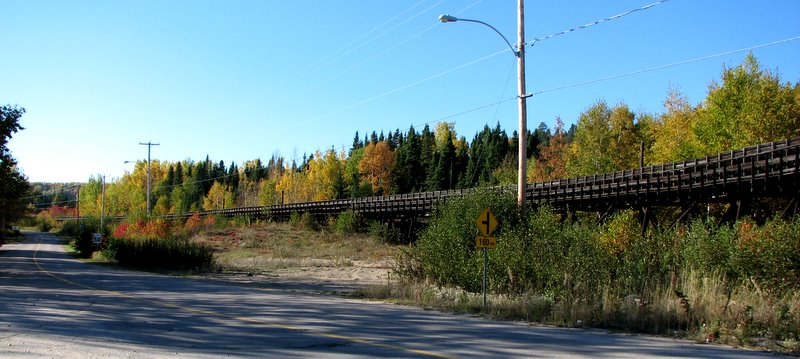
Arboriduc in Forestville, Côte-Nord, QC © Scotiana Octobre 2010
The arboriduc is also called ‘dalle humide’ or ‘floom’. This one, at Forestville, is no longer in use but it had been built in 1942 by the anglo-canadian company Pulp and Paper Mills Ltd. It was used to carry the wood logs from the estuary of the river Sault-aux-Cochons to the harbour on St Lawrence River where they were loaded on barges.
We would have liked to visit this nice old little chapel but must content with this beautiful postcard. The Trinity Church was built in Forestville in 1948 and was closed in 1979. It has been converted since in a museum which opened in 1994 under the name of ‘La Petite Anglicane’.
Of course, we can’t help introducing the subject of Labrador and our friend becomes still more talkative. He has worked there 😉 We look at maps of this isolated and wild region and he gives us a lot of information about the few towns that are to be found there: Fermont, Labrador City, Schefferville… industrial towns built round the iron industry as some names indicate.
The towns of Fermont, Labrador City and Churchill Falls are partially closed in by buildings arranged as a wall. In Fermont this wall consists of 440 dwellings (city offices, school, library, stores etc. and private homes). In the winter, this helps to block the dominant winds. It is referred to as Le Mur. In both Labrador City and Churchill Falls these walls are used to protect the remainder of the town against the winter winds. At Churchill Falls you notice the diminished height of the trees as you are at the apex of the roads for northern travelers of Labrador. They are now in the process of building a new gravel road from Churchill Falls to Happy Valley-Goose Bay. The open pit gravel road now in use is rough to say the least.
http://www.alinerclub.org/pierre/crossing_translab.html
How we would like to go there! At the Tourist Office we buy a lot of colourful postcards to make us dream of that day …
Now, if we want to see whales, our friend suggests, we’d better go to Les Escoumins or Tadoussac. Maybe we’ll be able to catch sight of one or two of the big cetaceans from the shore but, if we want to embark on a whales watching cruise, we must hurry for it is the end of the season and the companies are closing one after the other.
After looking for the arboriduc and taking some photos there, we leave Forestville and resume our road towards Les Escoumins.
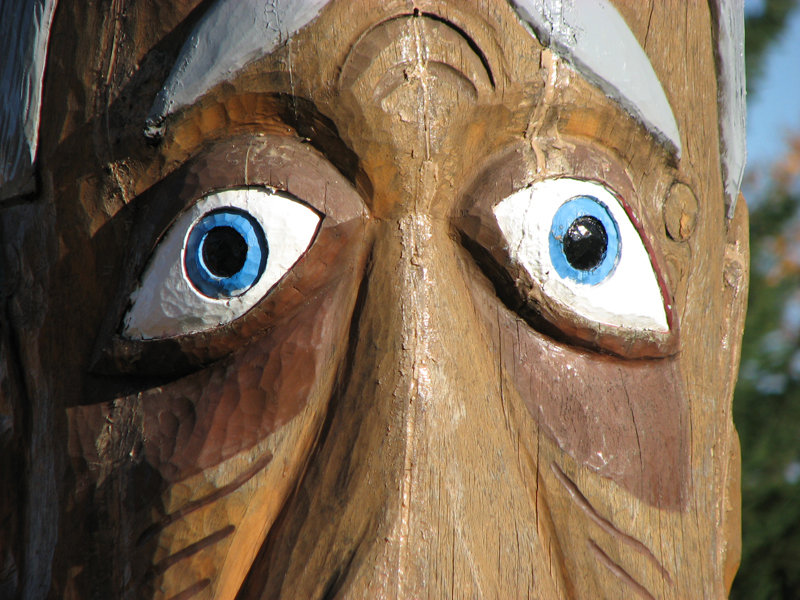
Detail of An Indian Sculpture by Denis St-Pierre. Longue-Rive, Côte-Nord, Province of Quebec. © Scotiana October 2010
The road goes on and on… Suddenly, at Longue-Rive, we stop ! Big eyes are staring at us. We get off the car, cross the road, and find ourselves in front of a nice wooden fairy-tale styled house, a sculptor’s house as the sign informs us. The big eyes, three pairs of them in fact, belong to Indian statues which are welcoming us into an extraordinary garden, full of vividly coloured sculptures and huge masks: among them a big cock and a superb peacock. It’s magical!

The Sculptor Denis St-Pierre with one of his favourite sculptures. Longue-Rive, Côte-Nord, QC - © 2010 Scotiana
And here’s the artist! He has got out to welcome us. We introduce ourselves. Denis St-Pierre is an internationally known artist for his antler, metal and stone carvings. In 2002, he was selected as the Canadian representative for the project to ‘Monument to Mankind’. Now he leads us into his workshop and we go from discovery to discovery… after the big statues and the masks we’ve discovered in the garden, our eyes now marvelled at a multitude of small carvings: all sorts of people, animals, trees and fantastic creatures are crowding on the artist’s workbench. It’s fabulous ! We had a great pleasure meeting this man and his creatures and didn’t feel like leaving the place.

Nice little figures carved by Denis St-Pierre in moose antlers Denis Saint-Pierre Longue-Rive Côte-Nord Quebec © 2010 Scotiana

Denis St-Pierre Nice little figures carved in moose antlers Longue-Rive Côte-Nord Quebec © 2010 Scotiana
We depart Denis St-Pierre’s enchanting kingdom at about 17 h, after being given the name and characteristics of every tree growing in his beautiful garden. As it is too late now for a whale watching cruise, we go back to Les Escoumins. We stay some time on the quay there, just in case. But no sign of the big sea creatures. We book at Hotel-Motel Le Pelchat and have a delicious supper at the restaurant in front, Le Bouleau. A good way to end the day!

Route des Baleines Signpost on Road 138, Province of Québec © Scotiana October 2010
6 octobre
Les Escoumins: We decide to make reservations for a zodiac cruise!
Essipit: The man who saw a big beautiful whale dancing in the St Lawrence!
Tadoussac: Whales on the St Lawrence!
Les Escoumins: Back to the starting point for a good night rest.

Otis Excursions - Whale Watching in Small Zodiac Boats © Scotiana October 2010
At the Pelchat Motel, in the morning, we finally decide to embark on a whales watching cruise and the receptionist make reservations for us with Otis excursions company. The weather is fine and we choose a zodiac cruise to get the best of this marvellous adventure. We will embark at 13 h at Tadoussac harbour… WOW !

Tadoussac Beach, Small Chapel, Church in hills of Tadoussac, QC © Scotiana October 2010
In the car again… we are very happy to go back to this nice little town !

Essipit, Première Nation Innu, Bienvenue - Quebec © Scotiana October 2010
On our road to Tadoussac, we stop at Essipit ! Tepees in the woods, signs with Amerindian symbols and writing. We immediately feel that we’ve arrived in an Indian reserve.
Essipit (known as Les Escoumins until 1996) is an Innu Indian reserve and community in the Canadian province of Quebec, located on the north shore of the Gulf of Saint Lawrence in the Côte-Nord region. It belongs to the Innue Essipit First Nation.
The reserve is named after the historical name of the Escoumins River, that around 1664, was known as Esseigiou. Charles Arnaud, who spent many years of his life among the Montagnais stated that the river was also called Etshipi, meaning “river of shells”. Essipit (known as Les Escoumins until 1996) is an Innu Indian reserve and community in the Canadian province of Quebec, located on the north shore of the Gulf of Saint Lawrence in the Côte-Nord region. It belongs to the Innue Essipit First Nation.
The reserve is named after the historical name of the Escoumins River, that around 1664, was known as Esseigiou. Charles Arnaud, who spent many years of his life among the Montagnais stated that the river was also called Etshipi, meaning “river of shells”.
The Montagnais have frequented the place for thousands of years, gathering berries that covered the rocks and adorned the mossy plains in the spring. The Jesuit Relations reported on the presence of “Excomminquois” in the region since 1611. It presented them however as an enemy nation of the French and distinguished them from the Montagnais of the region who were recognized as friends. It is assumed that they likely were Mi’kmaq tribes that from the middle of the 16th century onwards sporadically left their territory around Chaleur Bay and visited the North Shore of the Saint Lawrence Gulf.
In 1863, about 40 Montagnais people were counted at the Mission of Escoumins. In 1881, the Superintendent of Indian Affairs appointed surveyor Elzéar Boivin to delineate the land occupied by them. On July 23, 1892, the Government of Canada purchased the land and the Réserve indienne des Escoumins (Escoumins Indian Reserve) was formed.
In 1994, the reserve changed its name to Communauté montagnaise Essipit, made official by Commission de toponymie du Québec on June 7, 1996. On August 7, 2003, the name was changed again, and it is now known as Innue Essipit.
http://en.wikipedia.org/wiki/Essipit,_Quebec

Indian Teepee Structure in Essipit, © Scotiana October 2010
We will soon be able to build our own teppee in our garden 😉
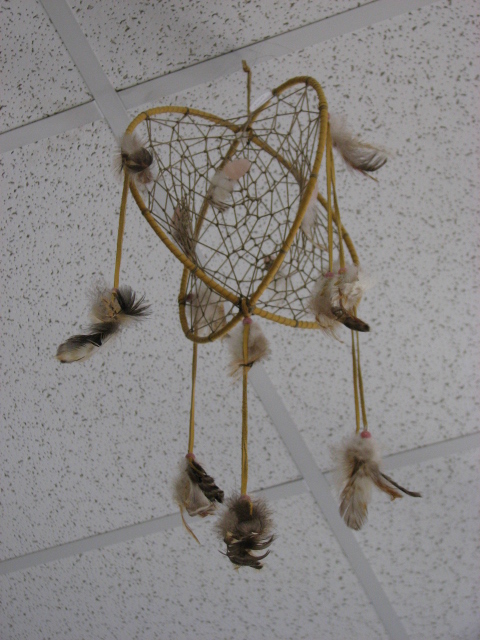
Indian Dream Catcher, Essipit, Innu Indian Reserve QC © 2010 Scotiana
We had been recommended to visit the local innu craftwork shop… it’s full of very interesting objects and we have a ‘coup de coeur’ for ‘les capteurs de rêves’, the dream catchers !
In Ojibwa (Chippewa) culture, a dreamcatcher (or dream catcher; Ojibwe asabikeshiinh, the inanimate form of the word for “spider”or bawaajige nagwaagan meaning “dream snare”) is a handmade object based on a willow hoop, on which is woven a loose net or web. The dreamcatcher is then decorated with personal and sacred items such as feathers and beads.
While dream catchers originated in the Ojibwa Nation, during the Pan-Indian Movement of the 1960s and 1970s they were adopted by Native Americans of a number of different Nations. Some consider the dream catcher a symbol of unity among the various Indian Nations, and a general symbol of identification with Native American or First Nations cultures. However, other Native Americans have come to see dream catchers as over-commercialized.
American ethnographer Frances Densmore writes in her book Chippewa Customs (1979, pg. 113), “Even infants were provided with protective charms. Examples of these are the “spiderwebs” hung on the hoop of a cradle board. These articles consisted of wooden hoops about 3½ inches in diameter filled with an imitation of a spider’s web made of fine yarn, usually dyed red. In old times this netting was made of nettle fiber. Two spider webs were usually hung on the hoop, and it was said that they “caught any harm that might be in the air as a spider’s web catches and holds whatever comes in contact with it.”
Traditionally, the Ojibwa construct dreamcatchers by tying sinew strands in a web around a small round or tear-shaped frame of willow (in a way roughly similar to their method for making snowshoe webbing). The resulting “dream-catcher”, hung above the bed, is used as a charm to protect sleeping children from nightmares. As dreamcatchers are made of willow and sinew, they are not meant to last forever but are intended to dry out and collapse as the child enters the age of wonderment.[citation needed]
The Ojibwa believe that a dreamcatcher changes a person’s dreams. According to Konrad J. Kaweczynski, “Only good dreams would be allowed to filter through . . . Bad dreams would stay in the net, disappearing with the light of day.”[4] Good dreams would pass through and slide down the feathers to the sleeper.
Another version from the same article was, “Luscious dreams pass through the center hole to the sleeping person. The bad dreams are trapped in the web, where they perish in the light of dawn.”
In the course of becoming popular outside of the Ojibwa Nation, and then outside of the pan-Indian communities, “dreamcatchers” are now made, exhibited, and sold by some New age groups and individuals. According to Philip Jenkins, this is considered by most traditional Native peoples and their supporters to be an undesirable form of cultural appropriation.
The official portrait of Ralph Klein, former Premier of the Canadian province of Alberta and whose wife Colleen Klein is Métis, incorporates a dreamcatcher.
The idea of a dream catcher was used by Margaret Salinger, daughter of J.D.Salinger, in her book of memoirs about her father, Dream Catcher: A Memoir.
http://en.wikipedia.org/wiki/Dreamcatcher
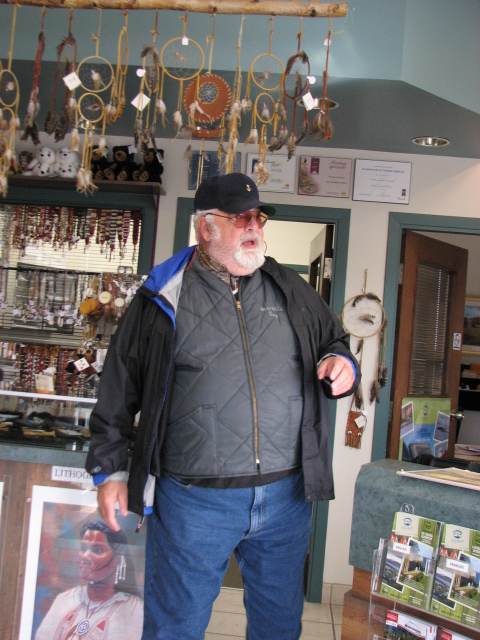
A Resident of Les Escoumins Who Witnessed An Humpback Whale Performing 7 to 8 Jumps Out Of The Water. Watch The Video Below To Hear The Story (Quebec French Language)
While we marvel at the many pieces of traditional Native American craftwork displayed in the shop, a man enters with the air of someone who has big news to tell and he begins to chat cheerfully with the members of the staff who seemed to know him very well. He must be a local. He speaks with such an irresistible Quebecois accent, accompanying his speech with so expressive gestures, that we stop our shopping to listen to him… the day before, while they were in their chalet, he and his wife had suddenly caught sight of a new whale on the St Lawrence.
Here, they seem to know each cetacean living in the local waters, loving them as pets and even giving them affectionate names. This one seemed to be a young one, nicknamed “Picotine” 🙂 because of the two white spots on her black tail ( picots in Quebec French language) and seems to be about three years old. She is big and beautiful, and they watched her for a long time, while she was happily diving and jumping out of the water. In 25 years, the man explains that he has never witnessed such an extraordinary sight!
After this remarkable performance, the man says good-bye and leaves. So captivated had we been by the storyteller that we stay a moment without speaking but Janice has had the very good idea to take a video of the whole scene.
What a good introduction to our whales watching cruise! We buy a few postcards and hurry on towards Tadoussac for it is already 11 h 30 !

- Tadoussac Harbour – Coast Guard Ship – “Cap d’Espoir”, QC © Scotiana October 2010
We arrive at Tadoussac at 12 h 15… and so eager are we to embark on our zodiac that we go directly to the harbour, looking for the Otis Company boarding dock 😉 Of course, it is still closed.
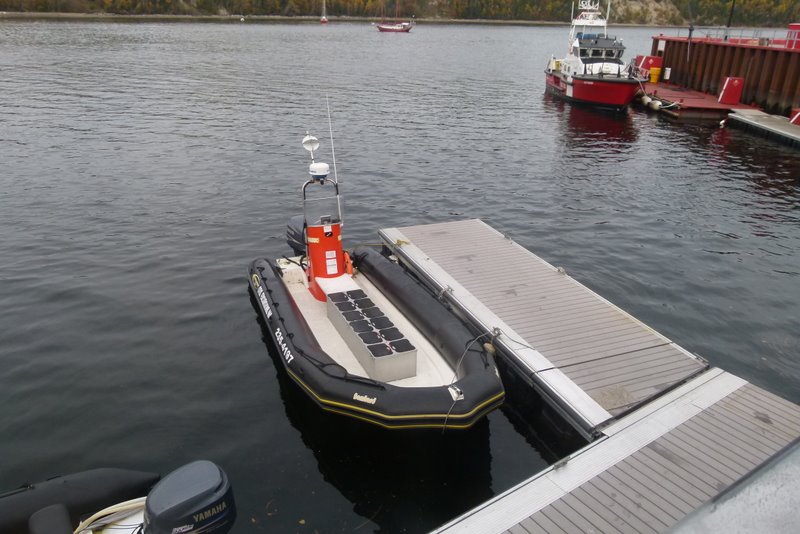
Otis Excursions Zodiac in Tadoussac Harbour © Scotiana October 2010
Here’s the zodiac, waiting for us in the harbour! Are we really going on the St Lawrence aboard this tiny little boat?
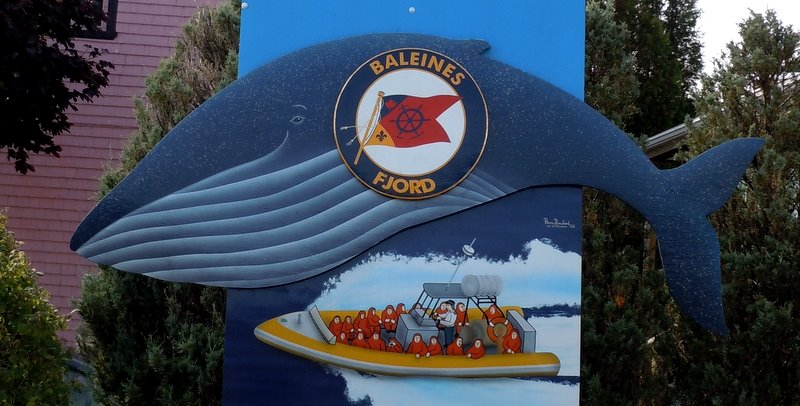
Zodiac Whales Watching Cruise Advertising Sign - Tadoussac, QC © Scotiana October 2010
I can’t help thinking with some anxiety about the big advertisement we’ve seen and photographed in the town and which could be entitled ‘The tiny little boat and the big creature’! It looks like a picture to illustrate the book cover of Herman Melville’s Moby Dick, except that the boat passengers are peaceful tourists only armed with cameras and not with harpoons! But will these huge beasts make the difference, I wonder! Anyway we’ve booked for a zodiac cruise and the die is cast!
Not enough time now to take a meal or to visit something, so we stroll around the place waiting for the boarding office to open. It’s quite pleasant for the weather is fine. The vivid colours of the boats in the harbour and of the nice wooden houses in town add their magic touch to the splendid autumn colours…
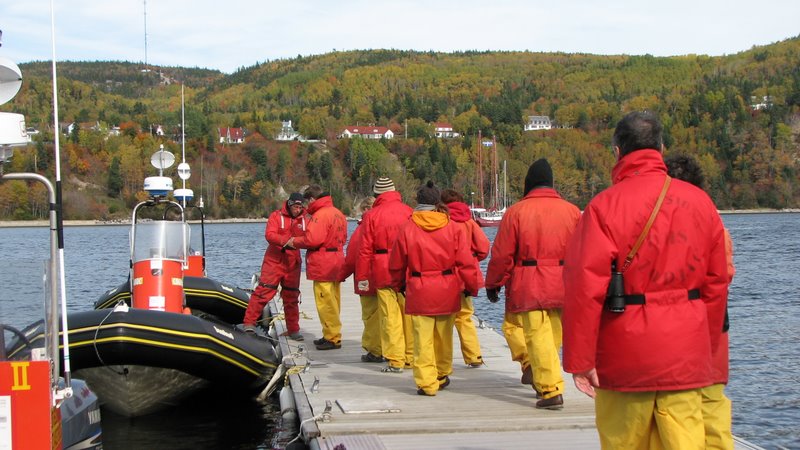
Embarking for our whales watching cruise aboard a zodiac © Scotiana October 2010
Time to embark! 12 passengers + the pilot = 13! No problem, we’re not superstitious !
Let’s go! Our pilot says ‘Fait frette’… Water temperature 2° C… survival time in the water before hypothermia: 15 minutes! I should have taken with me one of the Gideon Bibles we find in nearly every hotel in the country!

Great time! © Scotiana October 2010
Et c’est parti!
GREAT ! ‘ça brasse’, says Janice 😉 who reminds me that she can’t swim! But we trust Jean-Michel, our pilot. He seems to be the man of the situation!
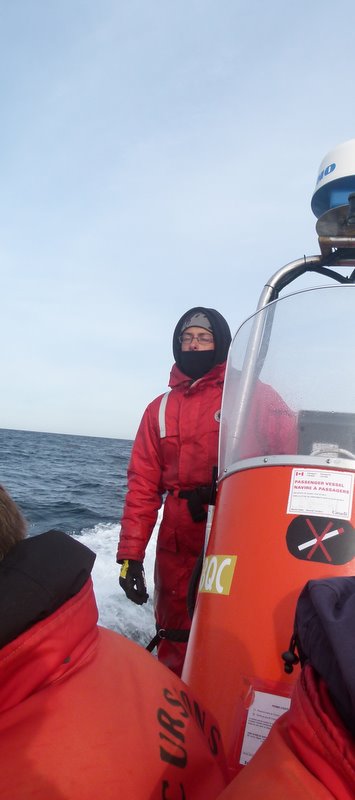
Our zodiac pilot Jean-Michel © Scotiana October 2010
It takes some time to find the whales… we hear him discussing on the radio, for he is connected with the other boats sailing in the area and the captains are constantly exchanging information… indeed, we can see a superb Dufour whales watching cruiser on the horizon, soon a bigger zodiac than ours will join it. The big and well-equipped cruiser must be quite comfortable to travel in but we don’t regret to make a three-hour journey on board of our little zodiac.

Looking for whales on the St Lawrence © 2010 Scotiana
Silence on tourne!
Here are the whales! And they are so close! Just in front of us… a few yards only! It suddenly came to our mind that they might be swimming under the boat… Mightbe or maybe?!
Anyway, it’s magical time! Everything is so quiet! So luminous! That’s really a great moment on our Blue Road adventure! We’ll never forget it!

Whales watching © 2010 Scotiana

Whales watching © 2010 Scotiana
.

Whales on the St Lawrence © 2010 Scotiana
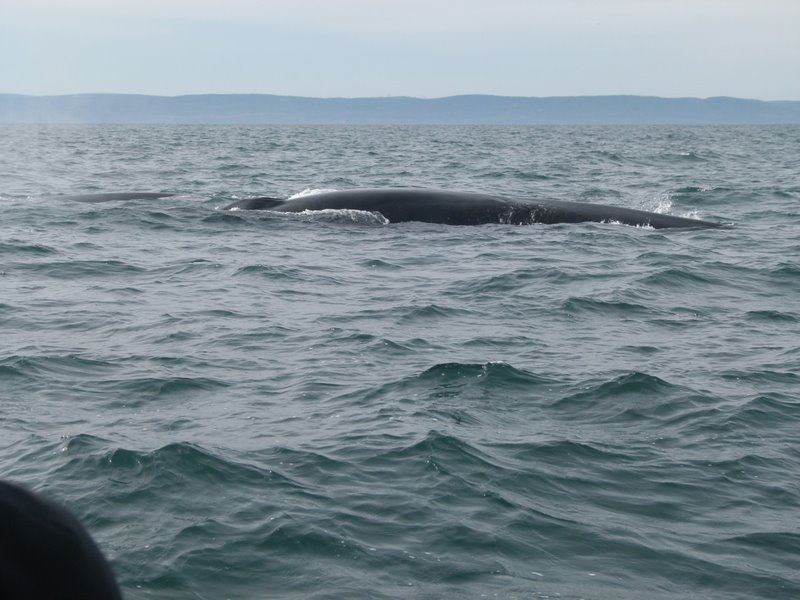
Whales on the St Lawrence © 2010 Scotiana

Whales on the St Lawrence © 2010 Scotiana
Jean-Michel is not only a very good pilot but he is also very knowledgeable about the whales and he tells us many interesting facts about them. Have I heard that we only see 10% of these big creatures? ‘My God’ as you say in Britain! Just imagine…
Difficult to say what kind of whales we’ve seen here, given the fact that we can see so little of the beast. There were many “common rorquals” for sure and maybe a blue whale. There seemed to be two distinct species swimming there.
The fin whale (Balaenoptera physalus), also called the finback whale, razorback, or common rorqual, is a marine mammal belonging to the suborder of baleen whales. It is the second largest whale and the second largest living animal after the blue whale, growing to nearly 27 meters (88 ft) long.
Long and slender, the fin whale’s body is brownish-grey with a paler underside. There are at least two distinct subspecies: the Northern fin whale of the North Atlantic, and the larger Antarctic fin whale of the Southern Ocean. It is found in all the world’s major oceans, from polar to tropical waters. It is absent only from waters close to the ice pack at both the north and south poles and relatively small areas of water away from the open ocean. The highest population density occurs in temperate and cool waters. Its food consists of small schooling fish, squid, and crustaceans including mysids and krill.
Like all other large whales, the fin whale was heavily hunted during the twentieth century and is an endangered species. Almost 750,000 fin whales were taken from the Southern Hemisphere alone between 1904 and 1979 and less than 3,000 currently remain in that region.The International Whaling Commission (IWC) has issued a moratorium on commercial hunting of this whale, although Iceland and Japan have resumed hunting: in 2009, Iceland took 125 fin whales during its whaling season, and Japan took 1 fin whale in its 2008-2009 Antarctic season. The species is also hunted by Greenlanders under the Aboriginal Subsistence Whaling provisions of the IWC. Collisions with ships and noise from human activity also significantly threaten recovery.
http://en.wikipedia.org/wiki/Fin_whale
The Blue whale (Balaenoptera musculus) is a marine mammal belonging to the suborder of baleen whales (called Mysticeti). At over 33 metres (108 ft) in length and 180 metric tons (200 short tons) or more in weight, it is the largest animal ever known to have existed.
http://en.wikipedia.org/wiki/Blue_whale
Now, time to go back to Tadoussac. The sun is setting, the whales are gone and it is getting colder and colder!

Jean-Michel, our zodiac pilot showing his expertise in sailors' knots © 2010 Scotiana
Many thanks to our friendly, learned and experimented pilot for this marvellous experience! He drove us back, safe and sound, to the harbour.

End of the cruise © 2010 Scotiana
We dock at the harbour at about 16 h.

Otis company's van, Tadoussac, QC © 2010 Scotiana
It’s time for us to take off our colourful sailor’s clothes! With some regret, I must admit…
But, we are cold and very hungry for we have had no meal since our breakfast so we now look for a restaurant in quest for a big bowl of hot soup.
Another stop, however, still deletes dinner time!

The Indian golden statue near Chauvin House at Tadoussac © 2010 Scotiana
A golden Indian invites us to visit a very picturesque old house!
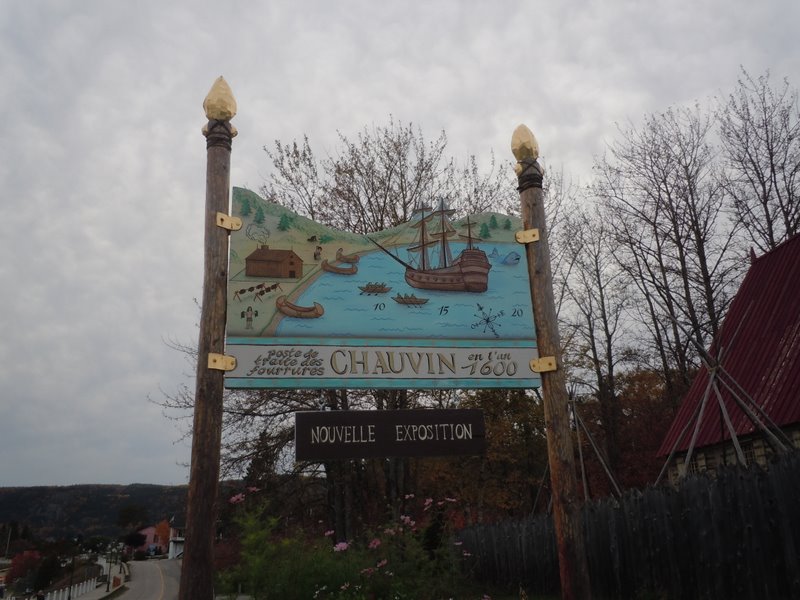
The illustrated historical board advertising Chauvin house at Tadoussac © 2010 Scotiana
Here’s the beautiful illustrated board advertising Chauvin House, which has been converted into a Museum. We can hear music coming out from the inside…
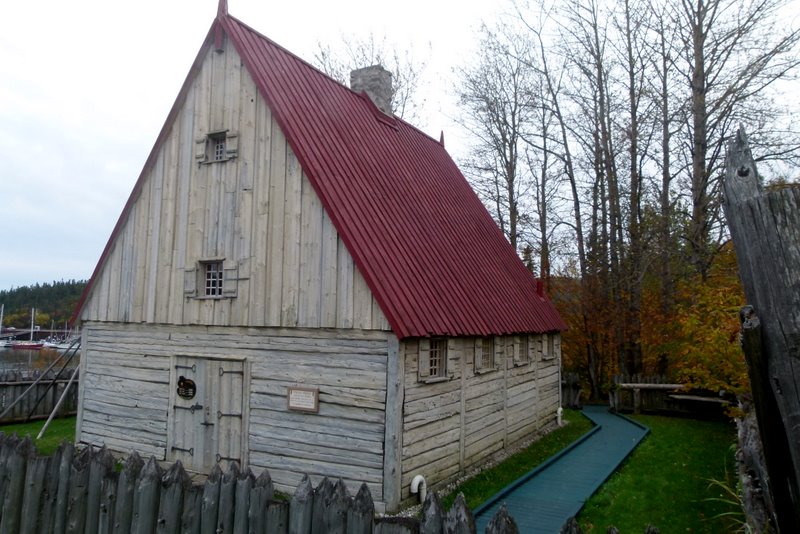
Chauvin House, Tadoussac's oldest house © 2010 Scotiana
WOW! Here’s the house. A very nice old wooden house, or it seems so, because it has been reconstructed after the original one.
Jacques Cartier came to the site in 1535 during his second voyage, and found there Montagnais hunting seal. Later that same century, it was visited by Basques, whaling on the river.[3]
Tadoussac was founded in 1600 [4] by François Gravé Du Pont, a merchant, and Pierre de Chauvin de Tonnetuit, a captain of the French Royal Navy, when they acquired a fur trade monopoly from Henry IV. Gravé and Chauvin built the settlement on the shore at the mouth of the Saint Lawrence River to profit from its location, but only five of the 16 men with them survived the first winter. In 1603, Samuel de Champlain visited the place. In 1615, the Mission of L’Exaltation-de-la-Sainte-Croix-de-Tadoussac, named in memory of a cross planted by Jean de Quen, was founded by the Récollets who sang the first Mass two years later.[3]
Tadoussac remained the only seaport on the river for 30 years. By the 17th and 18th century, it was the center of fur trade between the French and First Nations peoples. Competition over the fur trade increased among the nations. Historians believe the St. Lawrence Iroqouians, who inhabited the St. Lawrence river valley further west, were defeated and pushed out by the Mohawk by the early 17th century. Colonists from the Tadoussac area were involved in whaling from 1632 until at least the end of the century.
In the 19th century, with industrialization reaching other parts of Canada, tourists discovered the appeal of the rural village and wealthy Québécois built a number of villas. A Victorian hotel was built in 1864; it later was lost to a fire. In the 1940s, it was replaced by the large Hotel Tadoussac.
http://en.wikipedia.org/wiki/Tadoussac,_Quebec
No time to visit it now, so we’ll content ourselves with taking a few photos of it and reading the very interesting historical boards which we find at the entry.
We begin to be very hungry. Too late for a dinner, too soon for a supper… here’s another case of a day with just one meal!
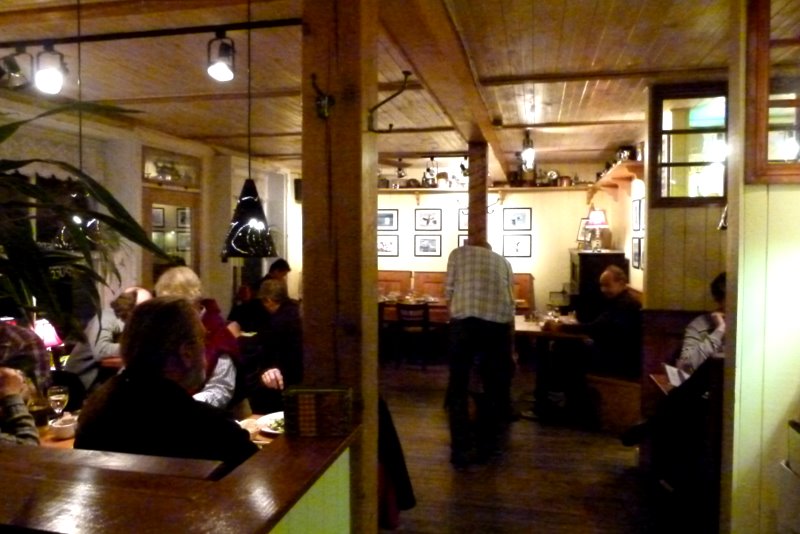
Restaurant La Bohème, in Tadoussac QC © 2010 Scotiana
We finally stop in front of restaurant La Bohème! Good name, good atmosphere and a very cheerful welcome! We won’t regret our choice!
Au menu : ‘Soupe aux lentilles et aux légumes’ – a huge pizza margarita for Janice – a ‘bagel au saumon’ forJean-Claude and a sublime ‘quiche lorraine’ and salad for me – We end on a delicious ‘brownie au chocolat’ for Janice, an ice-cream for Jean-Claude and… a fabulous ‘Tarte aux noix de pécan’ for me, the whole accompanied with a TRUE expresso! We won’t need supper tonight. Quel festin!
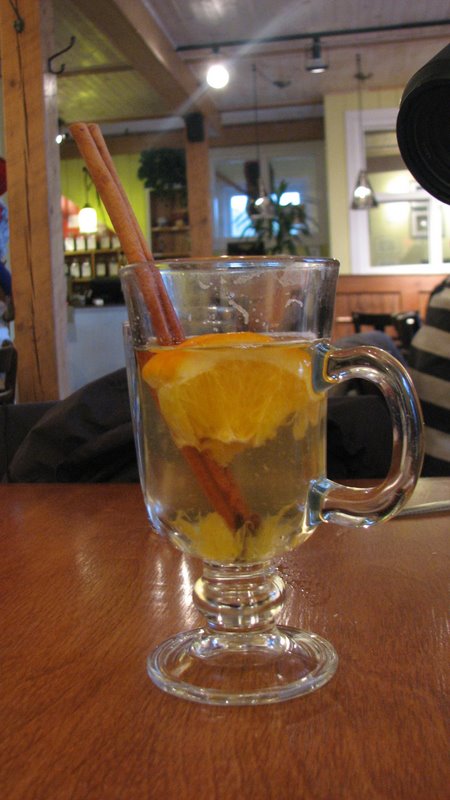
Hot cider with cinnamon - Restaurant La Bohème, Tadoussac, QC © 2010 Scotiana
And now, what about a big glass of hot cider with orange and cinnamon to end with !
Chin Chin!
A bientôt for the conclusion of our Blue Road adventure.
Mairiuna, Janice et Jean-Claude
Following the Blue Road on the Steps of Kenneth White in Quebec – Episode 1
Following the Blue Road on the Steps of Kenneth White in Quebec – Episode 2
Following the Blue Road on the Steps of Kenneth White in Quebec – Episode 3
Following the Blue Road on the Steps of Kenneth White in Quebec – Episode 4
Following the Blue Road on the Steps of Kenneth White in Quebec – Episode 6
Following the Blue Road on the Steps of Kenneth White in Quebec – Episode 7
Following the Blue Road on the Steps of Kenneth White in Quebec – Episode 8
Following the Blue Road on the Steps of Kenneth White in Quebec – Episode 9
Following the Blue Road on the Steps of Kenneth White in Quebec – Episode 10






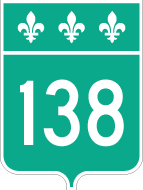
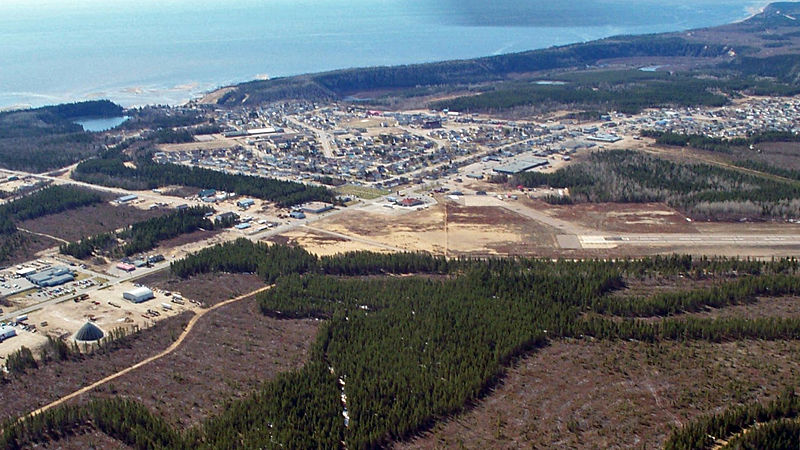
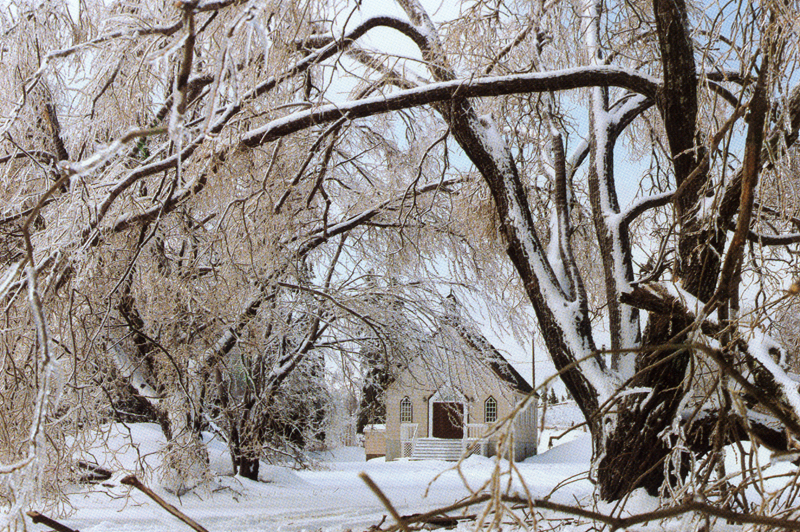
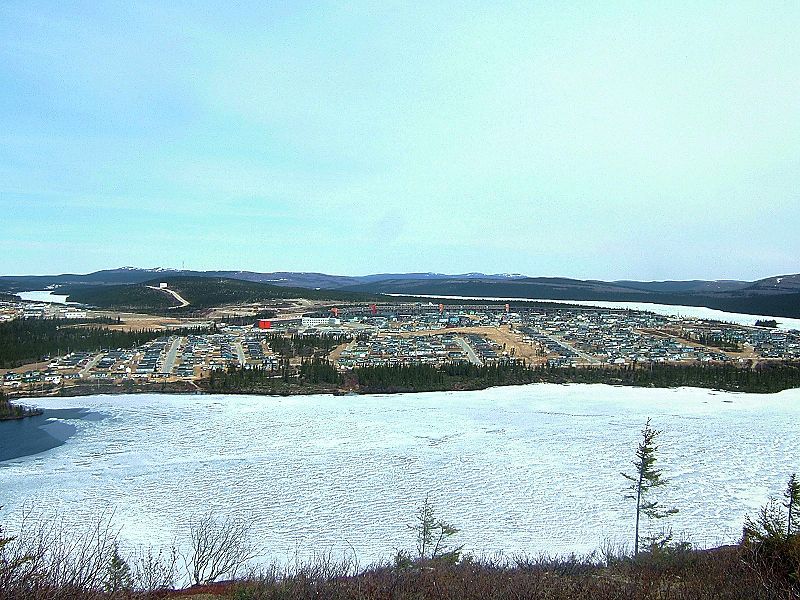

Leave a Reply